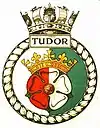 HMS Tudor | |
| History | |
|---|---|
| Name | HMS Tudor |
| Builder | Devonport Dockyard |
| Laid down | 20 September 1941 |
| Launched | 23 September 1942 |
| Commissioned | 16 January 1944 |
| Identification | Pennant number P326 |
| Fate | Scrapped September 1962 |
| Badge |  |
| General characteristics | |
| Class and type | T-class submarine |
| Displacement |
|
| Length | 276 ft 6 in (84.28 m) |
| Beam | 25 ft 6 in (7.77 m) |
| Draught |
|
| Propulsion |
|
| Speed |
|
| Range | 4,500 nmi (8,300 km; 5,200 mi) at 11 kn (20 km/h; 13 mph) surfaced |
| Test depth | 300 ft (91 m) max |
| Complement | 61 |
| Armament |
|
HMS Tudor was a British submarine of the third group of the T class. She was built as P326 at Devonport Dockyard, and launched on 23 September 1942. So far she has been the only ship of the Royal Navy to bear the name Tudor, after the Tudor period or Tudor dynasty.
Service
Tudor served in the Far East for much of her career in World War II, where she sank five Japanese sailing vessels, four Japanese coasters, and another Japanese vessel, as well as an unidentified sailing vessel north of Sumatra.
During the war Tudor was adopted by the Borough of Bridgend as part of Warship Week. The plaque from this adoption is held by the National Museum of the Royal Navy in Portsmouth.[1]
She survived World War II. On 23 April 1949, Tudor arrived at Halifax, Nova Scotia to begin a three-month tour in Canadian waters helping train Canadian surface vessels in anti-submarine warfare.[2] Tudor returned to the UK in July 1949, relieved by HMS Tally-Ho.[3] The submarine was sold for scrap on 1 July 1963 and broken up at Faslane.[4]
Notes
- ↑ Warship Weeks: Adopting Naval Vessels in World War Two | Royal Naval Museum at Portsmouth Historic Dockyard Archived 7 February 2012 at the Wayback Machine
- ↑ "Submarine on Loan". The Crowsnest. Vol. 1, no. 7. King's Printer. May 1949. p. 2.
- ↑ "The Year in Review". The Crowsnest. Vol. 2, no. 2. King's Printer. December 1949. pp. 2–4.
- ↑ "HMS Tudor (P 326)". uboat.net. Retrieved 20 July 2016.
References
- Akermann, Paul (2002). Encyclopaedia of British Submarines 1901–1955 (reprint of the 1989 ed.). Penzance, Cornwall: Periscope Publishing. ISBN 1-904381-05-7.
- Bagnasco, Erminio (1977). Submarines of World War Two. Annapolis, Maryland: Naval Institute Press. ISBN 0-87021-962-6.
- Colledge, J. J.; Warlow, Ben (2006) [1969]. Ships of the Royal Navy: The Complete Record of all Fighting Ships of the Royal Navy (Rev. ed.). London: Chatham Publishing. ISBN 978-1-86176-281-8.
- Chesneau, Roger, ed. (1980). Conway's All the World's Fighting Ships 1922–1946. Greenwich, UK: Conway Maritime Press. ISBN 0-85177-146-7.
- Kemp, Paul J. (1990). The T-class Submarine: The Classic British Design. Annapolis, Maryland: Naval Institute Press. ISBN 1-55750-826-7.
- McCartney, Innes (2006). British Submarines 1939–1945. New Vanguard. Vol. 129. Oxford, UK: Osprey. ISBN 1-84603-007-2.